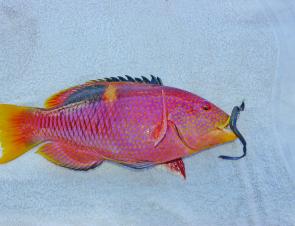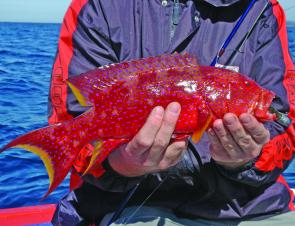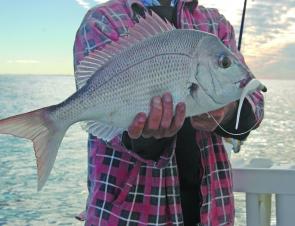The previous two articles in this series dealt with techniques for the snapper and spanglies where the lure was only kissing the bottom for short periods of time. To target the fish that live most of their life in amongst the coral, the wrecks and the rubble, we need to get our lure constantly in their strike zone.
You can catch a myriad of reef species by ‘bottom bashing’ soft plastics. Species such as coronation trout, pearl perch, gold spot wrasse (aka pigfish, which is a bad name but good to eat), Moses perch, small cods, small squire, reef trout and more, all add variety and interest to your catch.
Additionally, catching these critters forces you to brush up on both your fish identification skills and your knowledge of the Queensland fisheries’ regulations as to what and how many you can keep (legal lengths and bag limits). We use Grant’s Guide to Fishes as our staple reference text for reef fish identification. For the fisheries regulations, a print out of the government website’s latest version has always been a good choice. The advantage of a mixed bag is that you can ask your dinner guests, “Would you like the trout, the pearlie, the cod or the emperor?”
Again the standard Egrell S10, 30lb braid, 40lb leader arrangement works here. For about 90% of the pan-sized bottom fish that you hook, many rods will do that trick as far as fish fighting goes. Even lighter models from the Egrell range such as the Bear S4 are up to the challenge. Most of the fish caught bottom spanking with plastics will average less than 1kg in weight. You never know when Mr Big might come your way, so I reckon go with the S10 which gives you more lifting power than any other rod in its class. Apart from being prepared for bigger customers, the S10’s major advantage is that its special tip is perfect for the shaking technique that I’ll introduce later.
The S4 makes a very good bay snapper rod for those situations where you are using a lighter line class and a lighter leader, as you do to tempt the seemingly more wary fish from inside the bay. We also use the S4 offshore around the Cape on very shallow reefs on bright sunny days when we feel the need for a lighter presentation.
Originally, we used soft plastic Flirt worms in natural colours – roadkill, L.E. Snapper, watermelon, watermelon red, green pumpkin and others for our bottom shaking techniques. This was mainly because the skinny worms fitted best inside the mouth of fish less than 1kg.
I still reckon worms are tops, and additionally I see a lot of 7” Assassin Shads and 6” Sizmic Shads being used especially in baitfish whiting colours like alewife, whiting and crystal shad. The slender shad from Sizmic, is a crossover style between a worm and a shad; they have a skinny body but a similar side profile – perfect for the task!
Most of my early bottom grubbing was with jig heads. Today on the other hand, I’m all for the Texas rig. Use the weedless Texas rig for coral areas and the Texposed (exposed hook) rig for less snaggy bottoms.
The trick to pearl perch is to locate schools of them using your sounder around the deeper water to the east and around structure such as the St Paul wreck. A rough guideline is to target them in about 40m of water depth but I have seen a few come from the shallows.
Hopping on the bottom has always been the best technique for pearlies. Lifting the 5” soft plastic shad gently off the bottom rather than jerking the rod is what we call the pearlie lift. Use 5/8oz weights in the quicker currents. Cast ahead of the drift, about a 40m cast, and let the lure swing down so that it’s on the bottom as your boat drifts over the lure. Then switch yourself to the other side of the boat and do the pearlie lift (we use the same gentle yo-yo pump off the bottom with metal jigs). Alternatively, bounce the lure on the bottom – if they are around they’ll eat.
The other technique that I like is to let the lure hit the bottom, bring it up half a turn of the reel and then shake the lure, pause, then shake and pause again. Then feel for the bottom again and keep the process cycling along. It can be a pretty relaxing way to fish once you’ve got the bottom sussed, so having a clear view of the sounder and keeping an eye on the plot is a worthwhile if not critical exercise.
Extremely bumpy bottoms make bottom spanking more challenging, yet often more rewarding as the divots and hollows are prime fish holding real estate.
The folks run two independent sounders on the bigger of our boats and with two different brands they seem to be able to sit side by side without interference.
An alternative is to run multiple sounder heads off a single transducer. The idea is that everybody can see a screen. We are looking at enhancing this aspect of the boat’s layout. Possibly bigger screens would be even better and maybe there is merit in modelling something on the Japanese jigging boats that have a sounder head (or output screen) at each angling station.
Ten years ago no one would have put money on there being nationwide fleets of barra, bass and bream boats running two high end sounders each. Maybe offshore cast and retrieve boats will benefit from the same technology. I’m thinking the ultimate might be three sounders; one up the bow (or facing the bow anglers), one in the cockpit and the third at the helm.
Grubbing the bottom works well on all the offshore reefs, particularly those close to the Cape. If you want to add a colourful tasty mixed bag to your reef catch… get down deep and shake it baby!
Reads: 4483
This gold spot wrasse was taken from one of the Cape reefs on a Reaction Innovations Flirt worm rigged weedless on a Slider 1/4oz Texas jig head.

A Cape Reef coronation trout caught on a Blurp Shad soft plastic.

You’ll catch a few squire while prospecting around the sea floor. This squire took an Alewife 7" Assassin Shad shaken on the bottom.

Steve Bain with a Pearl Perch from Smith Reef caught on a watermelon coloured Gambler shad. We love the pearlies at this size, one fish per person on the plate.

The author Kim with a keeper Moses perch from Smith's Reef caught on a Gambler Watermelon 5" Super Stud Shad




